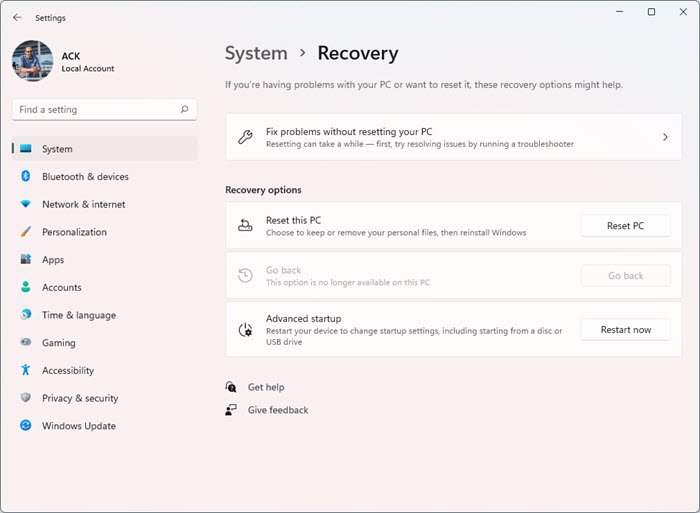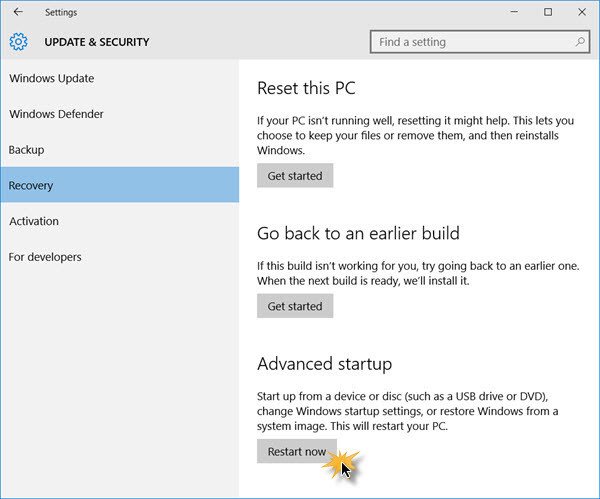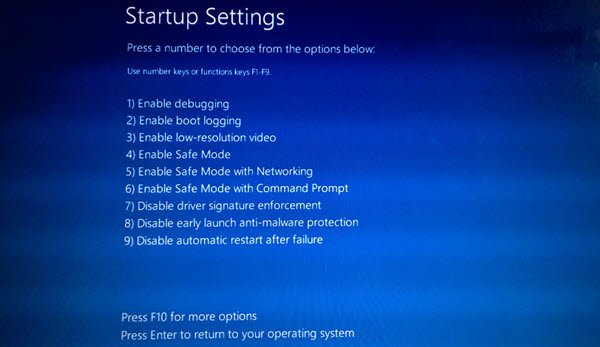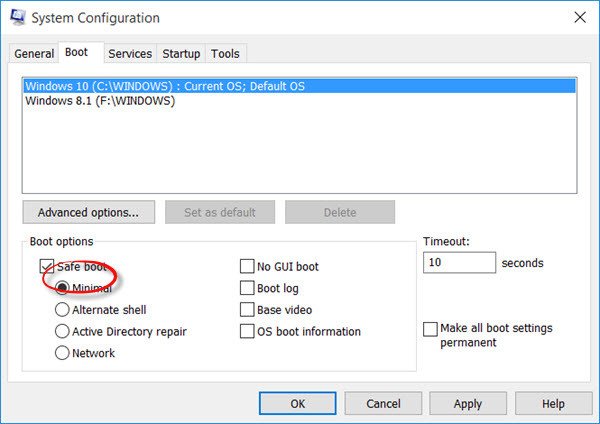Windows 11/10 Safe Mode loads the operating system with a minimal set of system files and device drivers – just enough to boot the Windows OS. In Safe Mode, the startup programs, add-ons, etc. settings, do not run. We usually boot into Safe Mode, when we need to troubleshoot issues. This post will show you how to enable and start or boot Windows 11/10 in Safe Mode. There may be other ways, but we will cover only 2 of the most convenient ways.
How to start Windows 11/10 in Safe Mode
There are three easy ways you can start Windows 11/10 in Safe Mode:
- Press Shift and then click on Restart
- Open Recovery section in Update & Settings and click on Restart now.
- Use MSConfig or System Configuration Utility and select the Safe boot and Minimal options setting and restart.
- Boot in Safe Mode using Command Prompt
- Via the Logon screen
- Enable F8 key and use it
- Boot from Windows Recovery Drive
- Using Windows Installation Media
Let us take a look at them in detail.
How to startup Windows in Safe Mode
1] Press Shift and then click on Restart

The easiest way to boot Windows into Safe Mode, would be to press Shift and then click on Restart. This will reboot your Windows computer into Advanced Startup Options.
2] Open Recovery section and click on Restart now
In Windows 11, open Settings > System > Recovery > Advanced startup and click on Restart now.

In Windows 10, open the Settings app > Update & Security > Recovery. Under Advanced startup, click on Restart now.

When you follow any of the two methods mentioned, your Windows computer will restart, and you will see the following screen.

Click on Troubleshoot to proceed.
Now follow the steps laid down in Advanced Startup options in Windows.
It will take you through the entire process starting with – Troubleshoot > Advanced Options > Startup Settings > Restart > Press No 4 key.
If you have followed the procedure correctly, you will finally reach Startup Settings screen, from where you will be able to enable Safe Mode.

Press the ‘4’ key, and your computer will restart and enter Safe Mode. To reboot in Safe Mode with Networking, press ‘5’ key. To reboot in Safe Mode with Command Prompt, press the ‘6’ key.

You will see a black desktop with a Safe Mode watermark in the bottom left and right sides.
3] Use MSConfig or System Configuration Utility
The other simple way, of course, is by using the built-in System Configuration Utility. From the Win+X Menu, open Run box, type msconfig and hit Enter.
Under the Boot tab, check the Safe boot and Minimal options. Click Apply/OK and exit. On a restart, your computer will enter Safe Mode directly.

You can now work in the Safe Mode.
Before you exit, remember to open msconfig and uncheck the Safe Boot check box, click Apply/OK and then on Restart, so that on reboot, your computer will not again boot in safe mode – but instead will boot to your desktop.
4] Boot in Safe Mode using Command Prompt
You can execute the following command in an elevated command prompt, and restart, to boot Windows 10 into Safe Mode.
bcdedit /set {current} safeboot minimal
Boot into Safe Mode with Networking
bcdedit /set {current} safeboot network
Boot into Safe Mode with Command Prompt
bcdedit /set {default} safeboot minimal bcdedit /set {default} safebootalternateshell yes
To exit Safe Mode, use:
bcdedit /deletevalue {current} safeboot
5] Via the Logon screen
- Once you reach the logon or sign-in screen, hold the Shift key down and click on the Power button and then select Restart.
- When your PC restarts, click on Troubleshoot > Advanced Options > Startup Settings > Restart.
- On the restart, select option 4 to boot into Safe Mode.
6] Enable F8 key and use it
You need to enable the F8 key first and then use it to boot into Safe Mode,
7] Boot from Windows Recovery Drive
You need to have already created a USB recovery drive.
- Now reboot the computer and boot to the recovery drive
- Select your keyboard layout based on your preferred language
- Select Troubleshoot > Advanced options > Startup Settings > Restart
- On the restart, select option 4 to boot into Safe Mode.
8] Using Windows Installation Media
Boot the computer to the Windows Installation Media
Click on Repair Your Computer
Select Troubleshoot > Advanced options > Command Prompt.
Execute the following command:
bcdedit /set {default} safeboot minimal
Select Continue to exit and boot into Safe Mode.
Is F8 Safe Mode for Windows working?
The F8 key that helped you earlier to boot the computer in Safe Mode is not enabled by default. You have to use this procedure using CMD to enable it first. Then you will be able to boot in Windows Safe Mode using the F8 key.
How do I boot into Windows Recovery?
The Windows Recovery Environment (WinRE) is a companion operating system installed alongside Windows, in a separate partition.
- You can use recovery media to boot into Windows RE.
- Execute
reagentc /boottorein an elevated command prompt and restart the device to boot into WinRE. - Execute
shutdown /r /oin an elevated command prompt and restart the device to boot into WinRE instead of Windows.
Also read:
- Cannot boot in Safe Mode in Windows.
- How to add Safe Mode to Boot Menu options in Windows.
- How to directly reboot in Safe Mode in Windows.
- PC is stuck and cannot exit Safe Mode.
WOW, what a complicate OS. That’s why I love my three Chromebooks.
Just like Windows 8 then. Used to be able to use F8 on startup to get a dodgy system working again. Now you can’t get into Safe Mode unless the PC is actually booting fully in the first place.
In other words if your PC is not booting into windows you are up the creek without a paddle because there is no (obvious) way to get into safe mode and troubleshoot. It seems MS now considers boot problems to be a thing of the past and therefor the facility to boot to safe mode (from cold boot) is now irrelevant.
But what would happen if you started the boot proccess and then pulled the plug (shut of power) right after the start. At present (Windows 7) you eventually get a screen giving choice of booting into windows or safe mode. Not advisable I know but at least it might offer the choice.
In Windows 8 you had to enable F8 key: See https://www.thewindowsclub.com/safe-mode-in-windows-8 and https://www.thewindowsclub.com/enable-safe-mode-windows-8-developers-preview :)
Thanks Andy. I stand corrected. I had missedforgotten those posts.
Erniek
Thanks for that – yes, I was aware of this workaround. Unfortunately it doesn’t help when you already have a machine that won’t boot properly, although I’ve seen another more involved workaround (booting from boot media then repair and command prompt and carry out the above instructions) that might help in those cases.
Ok..so booting into Safe Mode is complicated now?? right now with Windows 7 i just press F8 and the pick what i need.
I’m running Windows 10 on a Toshiba. I had no problem with the upgrade but the driver on my secondary monitor was outdated so I ended up purchasing a new monitor. I downloaded the new driver and had to restart. I cannot reboot. I turn on the laptop. I get the Toshiba screen then I get the Windows screen then I get the grey/black screen with the circle and arrow. The circle of death and arrow flash/blink constantly and the screen never progresses. Thus, I never get to the password page. I need to get to safe mode but can’t. I have tried multiple times to use F8 (tapping and constant hold), shift + F8, F12, F5, space bar and even taking out the battery and pulling out the cord during start up. Nothing has worked. Any other ideas please?
insert your WIndows 10 Installer at startup and repair
right,so after downloading 3 gigs from microsoft update to install win10, he needs to download and save another 3-4 gig onto a dvd/thumbdrive so he can have the equivelent of a win98 boot floppy? I like the os, but I kinda think MS dropped the ball on accessing safe mode in these last 2 editions.The main use of safe mode by most people is in a catastrophic fail,or malware not letting access to system.If U can’t load,you can’t access,and if you cant access the system when it loads,you cant go to safemode from inside.make it where if the system fails to load 3 consec x’s it offers safemode.Thatway we can just force power off before loading 3x’s & wahla! safe mode option!
I have no win 10 startup disk since it was downloaded and I was not told about the changes to getting into safe mode.
How do I BOOT into safe mode when win 10 will not start up?
Thank you! I was stuck at the login (spinning blue circle) after going from Windows 7 Pro to Windows 10. Unplugging devices (wi-fi adapter) and unplugging and plugging back my mouse and keyboard worked.
If Windows can’t read the configuration twice, it will probably start
the windows recovery enviroment.. So is not that complicated.. If
windows don’t start the windows RE, then the chances of start in safe
mode aren’t that big .. But is nice to havde F8 option anyway, I loved
it to, but more and more things are automatic now so in some cases you
can save some headache.. but also the other way around visa visa..
All the times I’ve problems with booting Windows, the windows RE started up automatically and I could start troubleshooting, its very rare that the windows don’t start up automatically.. And if it dont start you probably needed the
rescue disk in the first place..
Just start the computer multiple times and at one point the windows RE (where you can pick safe mode) will start automatically – it mostly comes after twice attempts if Windows can’t read the system configuration. You can also use a rescue disc and open an elevated prompt an enable the F8 key as mentioned above. You can also keep shutdown the PC on the power button right before the loading circle comes up several times and the windows RE will come up.. There is a lot of options, but most people just dont recognize it and give up at instance.
Remember if your computer can’t start the windows RE automatically you probably needed the rescue disc in the first place, because there will be a little chance of a succesfull boot in safe mode if it can’t start the Windows RE by itself.
There is a far simpler way of restoring the F8 key to get into Safe Mode.
In the run box, just type: bcdedit /set {default} bootmenupolicy legacy
If you want to revert to not having the F8 safe mode option, then go back to the run box and type:
bcdedit /set {default} bootmenupolicy standard
i had problem with screen freezing after entering password after upgrading from windows 7. I had to unplug the uusb wifi adapter. But why cant Windows tell us this. I spent ages trying to get past that. Its not straight forward upgrade and takes ages to do. How many people have rolled back to 7?
How do you boot into safe mode on startup in windows 10. Say you have a nasty virus and all you can do is a cold shut down using the Power button. So how do we get to safe mode on that startup. Thanks much !!!
Doesn’t using System Configuration Utility (2 above) help you?
Got it !!! Thanks !!!
I cant get into desktop screen, it keep showing Error code 0xc0000021a & restart is like a loop ,
what should i do?
Here’s my problem: Asus laptop. Upgrade from Windows 7 to Windows 10 over internet. When trying to startup now it goes to a black screen stating: Running Diagnostics. So there is no log in screen. Pressing F8 gives the option to select F2 which allows you to choose to boot from bootable disc. I want to create an external harddrive with the boot file but can’t find these files anywhere to download? My other laptop is a macbook so can’t create the disc from there either. Any help will be most gratefully received.
Hi, I was wondering if u could help me with my issue. I recovered my windows with a previous recovery point on W10 on safe mode, without uncheking the “Safe boot” box. Now after it iniciates asus, It fails the recovery because its on safe mode everytime I turn on my Pc.
A sol. could be uncheking safe boot without opening windows, in the Bios, but i don’t know how to do this on Asus Windows 10. Thx
windows 10 sucks!!!! it destroy my computer at work!
Hi, to boot into safe mode or with a variety of tool options, hold down the windows key and alt key and press the pic start button. If it doesn’t work, do it again. It will work first, second or third time. It is a bit of a pain but the f buttons don’t work on Windows 10
Run msconfig from the c:msconfig. There you will see the boot dialogue. Change the setting there
Switch off. Hold down the windows key and the alt key. Reboot. You may have to do this a few times but it will take you into safe mode
This article is incredibly ridiculous! Typically, people don’t need to boot into safe mode if they are already logged into their computer and using it! You need to boot into safe mode typically when there is a problem that stops you from booting the normal way. Using f8 was a convenient way to get into safe mode. Why Microsoft would change that is beyond me!
You are pretty smart. Why you are here at first. Let the other teach each other. At least he is trying for something better unlike you.
See https://www.thewindowsclub.com/windows-8-fails-to-boot-automatic-repair-refresh-reset-pc-fail
Ummm, this is not booting into safe mode, this is merely switching over into safe mode.
That is not true, I have had a few machines with windows 8 on them and never once had to enable F8 to enter safe mode.
Thank you
He’s right. None of this helps. I need an SD or something to boot from.
Every single remedy that I have read ASSUMES THE CPU IS ON AND OPERATING!!!!! My friend’s Dell CPU got a Malware virus and she didn’t have enough sense to NOT click on it. She called the 800 number and the scammers wanted $200 and all their bovine spatter. BUT…too late – now it won’t boot. I’ve been working with computers and LANs for +30 years and have NEVER seen anything so STUPID as whoever wrote Windows 10 and removed the manual ability to cold start the CPU to enter Safe Mode. I refuse to accept that ‘auto-repair’ song and dance – I choose to believer rather that this was driven by their market dept. to get rich from selling additional software. Oh – and that CD or thumb-drive remedy? Well, if the CPU won’t boot, how will it read ANYTHING? Cheese!!!! Whatever – does anyone out there know ANY method to cold boot a CPU with Windows 10 so that one can enter Safe-Mode and remove that damned malware???? (Yes, the hard drive and monitor work, but nothing comes up with an option to enter Safe Mode)
It works the same way installing an OS works, it can still read things even without an operating system, if you have to, go to the BIOS and set the drive to the number 1 on the list.
On a slightly different note my windows 10 all of a sudden does not recognize the 6 key. Either on top row or calculator type keyboard .And 6 is part of login, so I can’t even open the computer
Any ideas?
Also the Ubuntu OS.
this is work definitly try more time to 2 3 4 and work